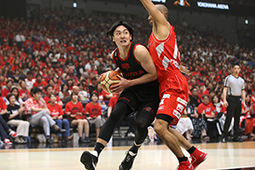Home > Highlighting JAPAN > Highlighting Japan October 2019 > THE SPORTING LIFE
Highlighting JAPAN


Dream Arena
Japan’s new professional basketball league aims to provide outstanding entertainment that is grounded in the local community.
The B. League was established in 2015 as the new top league of basketball in Japan, replacing the two longstanding leagues. According to B. League Chairman Masaaki Okawa, the league was founded to energize Japan through basketball, with teams no longer merely publicizing a company, but instead representing their communities across Japan.
The B. League is split into two divisions, B1 and B2, each with eighteen teams. The thirty-six teams in all represent communities from Japan’s northernmost main island of Hokkaido to southernmost Okinawa Prefecture. B1 and B2 are further divided into three local divisions with six teams in each. The teams play a minimum of sixty league matches per season, with the top teams proceeding to the championship playoffs. Teams are promoted or relegated between the leagues based on their performance, financial health and arena capacity.
B1 teams are required to have a home arena with a capacity of 5,000 or more spectators, which is one or two thousand more than the average capacity of a basketball arena in Japan. One reason for encouraging higher attendances is to create an exciting atmosphere not just in the stadium but for audiences watching on TV. When the B. League began soliciting for entries, many teams and municipalities worked to meet the requirements.
“I had high expectations for the B. League,” says Okawa, explaining the high standards for participation that he set.
For a professional sport to succeed it has to grow, meaning improvements in the quality of play and an increase in the number of spectators. The B. League has three missions: providing entertainment of a high enough standard that spectators will enjoy a match regardless of whether their team wins or loses; developing players and a team that can compete to an international standard through improved competition and an increase in the number of players; and realizing a community-based “dream arena” where people can enjoy their lives through sports.
During the season, teams play two matches every weekend, with an average of 6,000 spectators attending each match. Because games are played over two days, supporters of opposition teams are likely to stay overnight and enjoy the local sights, food and drinks, according to Okawa. Basketball tourism can be expected to have an impact on the local economy, he says.
Through measures such as offering “luxury” seats in harder-to-sell parts of the arena—these enabling spectators to enjoy the match in a more relaxed manner—the annual number of spectators increased from 2.24 million in the first season to 2.59 million in 2018/19. The B. League hopes to develop more players of the standard of Rui Hachimura and Yuta Watanabe, who play in the NBA, the world’s top professional league. In developing its players and squad, each team also provides coaching to young people in the community. The B. League meanwhile broadcasts matches, highlights videos and player interviews online, enabling basketball fans to enjoy the sport at any time on their smartphones or PCs.
The new B. League is evolving day by day with the goal of creating a “dream arena” by providing high quality matches and associated entertainment so that people can enjoy basketball in the wider arena of their local community.
© 2009 Cabinet Office, Government of Japan









